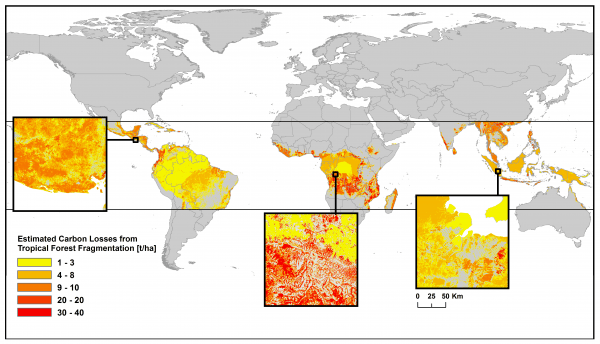UMD Geographers take part in the LDCM Launch from venues near and far
On the 11th of February 2013, NASA launched the Landsat Data Continuity Mission (LDCM), which once operational will become known as Landsat 8, from Vandenberg Air Force Base (VAFB) in California. LDCM will help continue the longest continuous data record initiated by Earth Resources Satellite – 1, now called Landsat 1, in 1972. The launch was the culmination of more than a decade of political, fiscal, and scientific negotiations, as well as approximately six years of physical construction of the satellite and sensors by engineers at Ball Aerospace, NASA, and Orbital Sciences Corporation. Many members of the UMD Department of Geographical Sciences have been participating in the Landsat Science Team for years, and the launch was eagerly anticipated by all who study the Earth from space. Members of the department watched the Atlas-V rocket carry LDCM into space from venues both near and far: Alyssa Whitcraft, Inbal Becker-Reshef, Eric Vermote, and Martin Claverie all attended the launch in person, while the department sponsored a Launch Celebration at the Geographical Sciences offices at UMD.
Alyssa Whitcraft, a graduate student and NASA Earth and Space Science Fellowship recipient, was invited by NASA to participate in a “NASA Social,” an event designed to engage the wider population through the use of social media (e.g. Twitter, Facebook, Google+). The event involved a full day tour of the Vandenberg Air Force Base as well as a meet-and-greet press conference the day before the launch with many crucial members of the LDCM team, including Dr. Jim Irons of NASA and Dr. Tom Loveland of USGS (co-chairs of the Landsat Science Team). The press conference also featured those involved in the construction of the LDCM satellite and the sensors on-board (Operational Land Imager (OLI) and Thermal Infrared Remote Sensor (TIRS)), as well as Colonel Armagno, the commander at VAFB who would eventually give the “clear for launch” of the Atlas-V rocket carrying the LDCM satellite. After the press conference, Alyssa and the rest of the NASA Social crew had the opportunity to get up-close-and-personal to the Satellite Launch Complex (SLC) 3 and the Atlas-V rocket it would launch the next morning. The experience was unforgettable, and could only be topped by the excitement of seeing and hearing the rocket safely carry LDCM into orbit at 10:02 AM PST. All of this information was shared live via Twitter and Facebook, a feed of which the UMD launch party back in College Park watched alongside the launch itself. NASA Social was such a success, the hash-tags #Landsat and #LDCM were the #2 and #3 trending topics on Twitter in the United States, drawing increased attention from both the media and the general population to this important step forward in Earth observing sciences.
Meanwhile, Drs. Becker-Reshef, Vermote, and Claverie participated in Science Team meetings, discussing parallel processing of data from LDCM and the European Space Agency’s Sentinel-2a/2b missions, ensuring interoperability between the datasets which together can provide a 3-4 day temporal revisit of the Earth’s surface. On the morning of the launch, they attended a celebratory brunch hosted by NASA in nearby Buellton, as well as a special VIP launch party at Providence Landing Park in Lompoc, CA.
At the Department of Geographical Sciences, many members of the department as well as external partners from various Government agencies attended the department-sponsored party. In all, over 60 people were present to watch the live NASA streaming coverage that was projected on a large screen. During the party and prior to the launch, graduate student Mary Lindsey and Research Assistant Professor Janet Nackoney showed educational videos, both current and historic, about the NASA Landsat program and the construction of the Landsat 8 satellite and sensors.
Since the launch LDCM has successfully completed every post-launch process, and as of 21 February 2013, both the OLI and TIRS sensors have been supplied with power and are in the process of undergoing a heated drying-out process to eliminate any water or other Earth & atmosphere debris occurring as a side-effect of the launch. One-hundred days after launch, imagery from Landsat 8 will become available to the public, so check http://ldcm.nasa.gov/or http://landsat.usgs.gov/in late May to see some new and exciting Earth observations.
NASA Social events are open to practically everyone, and are a wonderful way to engage with experts on Earth and space science as well as help generate public interest in NASA missions, a crucial undertaking toward ensuring continued support for NASA. For more information on registering for and attending a future NASA Social event, go to http://www.nasa.gov/social.
*Photo provided by Kevin Baird.
Published on Tue, 03/05/2013 - 12:42


